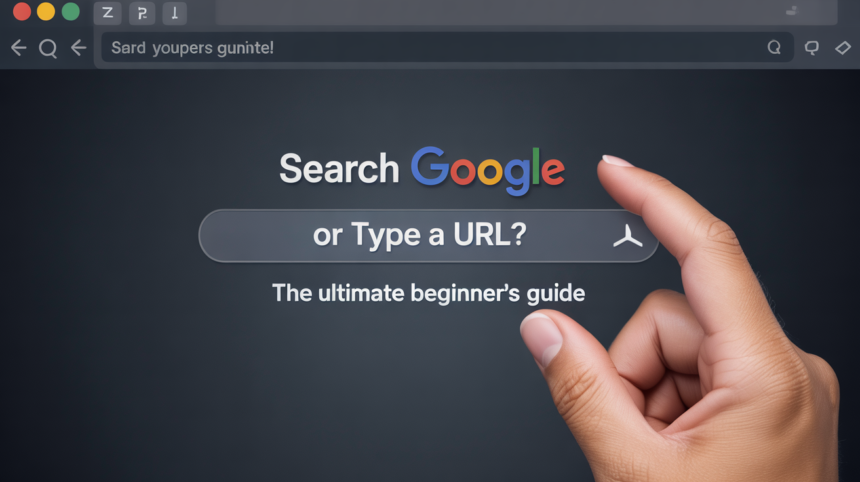Has the text Search Google or type a URL appeared in the address bar when you launched your browser? It’s something we see all the time, yet many people don’t really know what it means or what the difference is between the two actions. If you’ve ever paused and wondered whether to type something in or just click enter, you’re not alone.
In this guide, I’ll walk you through everything you need to know about that common prompt — from what it means, to how it affects your browsing, and even how you can maximize your online experience. This article is written in simple, clear language, perfect for beginners or anyone who’s ever felt lost in the digital world.
1. What Does “Type a URL or Search Google” Mean?
When you open a web browser like Google Chrome, Safari, Firefox, or Microsoft Edge, you’ll often see a message inside the address bar that says:
“Search Google or type a URL”.
This message is simply telling you that you have two options:
-
To search Google, enter a word, query, or phrase (for example, “best pizza in New York”) and hit Enter. You will be directed to the Google search results as a result.
-
Enter a URL: You can go straight to a website by entering its address, such as www.amazon.com, if you already know what it is.
So the message is just giving you a choice. It’s like a fork in the road — do you want directions or do you already know the destination?
2. The Difference Between Searching and Typing a URL
Let’s break it down:
Searching Google
You are posing a query or seeking a specific item when you conduct a Google search. You don’t always know where to go yet — you’re looking for the best place to find what you need.
Example:
When you search for “how to fix a flat tire,” Google returns a list of blogs, videos, and websites offering solutions.
Typing a URL
Entering a URL will take you directly to a certain website. If you already know the address, this is quicker and more straightforward.
Example:
Without seeing search results, you input www.facebook.com and are taken straight to Facebook.
3. When to Search and When to Type
Here’s a simple way to decide:
| If You… | Do This: |
|---|---|
| Don’t know the exact website | Search on Google |
| Want to learn, compare, or explore options | Search on Google |
| Already know the site name or address | Type the URL |
| Want to avoid ads or scams | Type the URL |
Tip: If you’re ever unsure, searching is usually the safer option. But once you trust a site, it’s better to type the URL directly.
4. What Is a URL and Why It Matters
A URL stands for Uniform Resource Locator — but you don’t need to remember that. You only need to be aware that a URL is a page’s unique web address on the internet.
Examples:
-
https://www.google.com -
https://www.netflix.com/browse -
https://en.wikipedia.org/wiki/Internet
Think of it like a phone number for websites. Just like you dial a number to call someone, you type a URL to “call” a website.
Why URLs Matter
-
They take you directly to the website you want.
-
They help you avoid fake or scam websites.
-
Utilize your browser’s history to return to previously visited websites.
5. Real-Life Examples: Search vs. URL
Let’s say you want to buy a pair of sneakers.
Searching Google:
You type: “best sneakers for running”
You get links to:
-
Review websites
-
YouTube videos
-
Blogs
-
Shopping sites like Nike, Adidas, Amazon
Typing a URL:
You type: www.nike.com
You go straight to Nike’s official site and start browsing sneakers.
Both are useful — it depends on whether you want information or are ready to shop.
6. How Browsers Handle It
Google Chrome
The address bar is called the omnibox — it lets you search or enter URLs.
Safari
Same idea. You can search or enter a URL directly.
Firefox and Edge
All modern browsers work the same now. You can type anything in the top bar, and it will either:
-
Take you directly to a site, OR
-
Show you search results
Some browsers even suggest websites or complete your search as you type, thanks to autocomplete.
7. Tips to Make Your Browsing Faster and Smarter
-
Bookmark sites you visit often (like Gmail, Facebook).
-
Use browser history to revisit sites you’ve been to.
-
Double-check URLs before clicking to avoid phishing.
-
Use autocomplete: Most browsers remember your habits.
-
Use incognito/private mode when you want privacy.
8. Common Mistakes and How to Avoid Them
1. Typing in the wrong place
Some people still type a search into the Google homepage’s box, even though the address bar does the same thing.
Fix: Just use the address bar — it does both jobs!
2. Falling for fake sites
Typing slightly wrong URLs like amaz0n.com instead of amazon.com can lead to scam websites.
Fix: Bookmark trusted sites or double-check spellings.
3. Getting overwhelmed by search results
Too many ads or irrelevant results? Try using more specific keywords like:
“best budget running shoes for flat feet 2025”
“running shoes”
9. Personal Story: How I Learned the Difference
When I first got into the internet back in the early 2000s, I didn’t know the difference between searching and typing URLs. I remember once wanting to go to Yahoo, so I typed “Yahoo” into Google and then clicked the first link. It worked — but I didn’t realize I could’ve just typed www.yahoo.com and saved time.
Later, I started running a blog and realized how much better it is for a website when users go straight to the URL — it’s faster, safer, and more direct. That’s when I really started paying attention to how I browsed.
Today, I teach digital literacy to older adults, and this is one of the first topics we cover. You’d be surprised how many people still think the search bar and address bar are two different things!
11. Final Thoughts
The message “Search Google or type a URL” might seem small and unimportant, but it’s actually a helpful reminder of how the internet works. Understanding the difference helps you browse smarter, stay safe online, and save time.
Remember:
-
Search when you’re exploring.
-
Type the URL when you know where you’re going.
Once you get used to this, the internet becomes a lot easier — and even fun — to use. Whether you’re doing research, shopping, learning, or just browsing, knowing when to search and when to go straight to the source is a small skill that makes a big difference.
10. Frequently Asked Questions (FAQ)
Q: Is it better to search or type the URL?
If you know the website, typing the URL is faster. But if you’re unsure or want more options, search it.
Q: What happens if I type a word instead of a URL?
Your browser treats it as a Google search and shows you results.
Q: Can I simply state the name of the website rather than the complete URL?
Yes, browsers are smart now. Typing “Facebook” and hitting enter usually takes you to www.facebook.com.
Q: Why do browsers say “Search Google or type a URL”?
It’s a reminder that the address bar does both — no need to go to google.com manually.
Q: How do I know a site is real and safe?
Look for https:// and a small padlock icon next to the URL. These show it’s secure.




